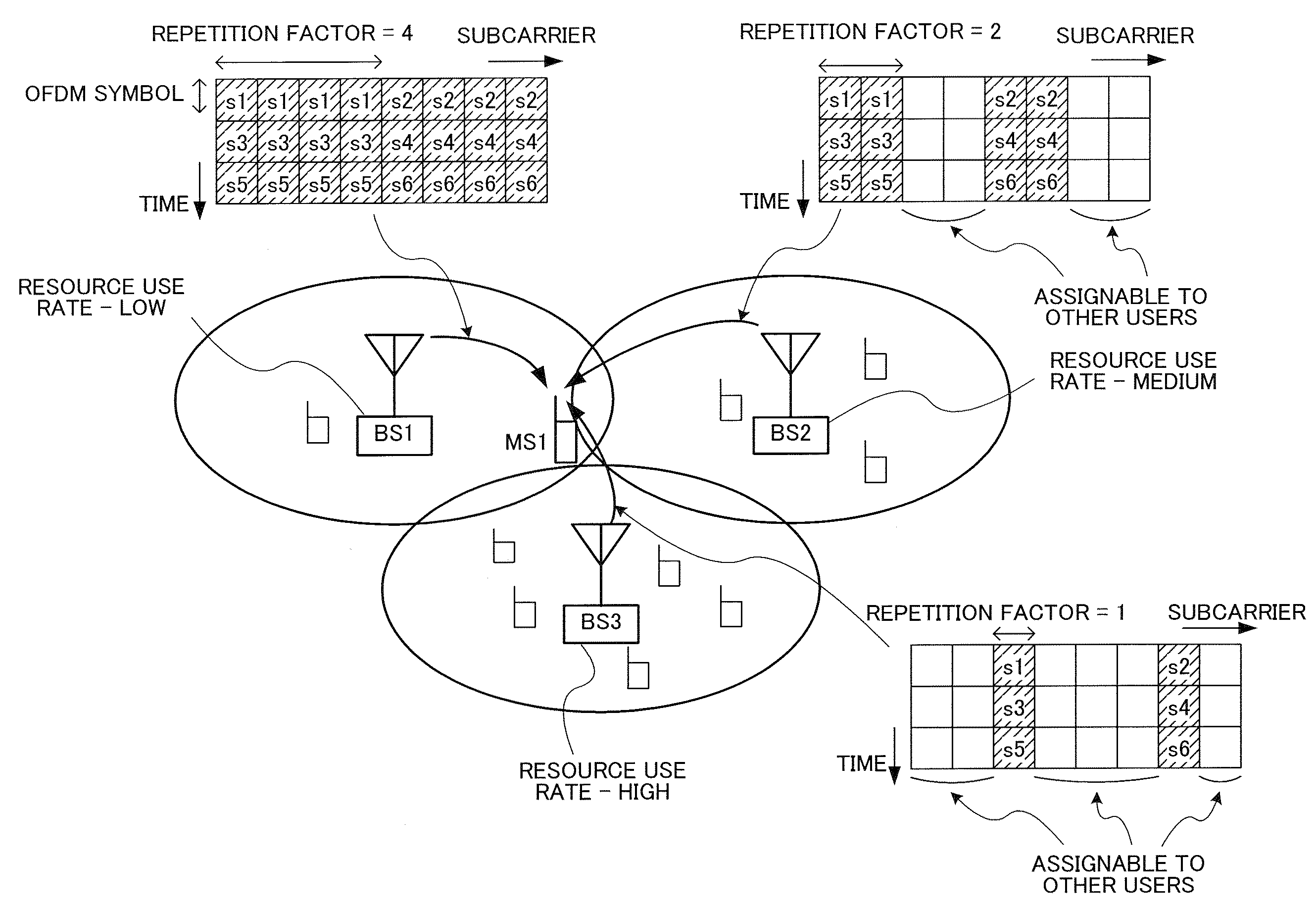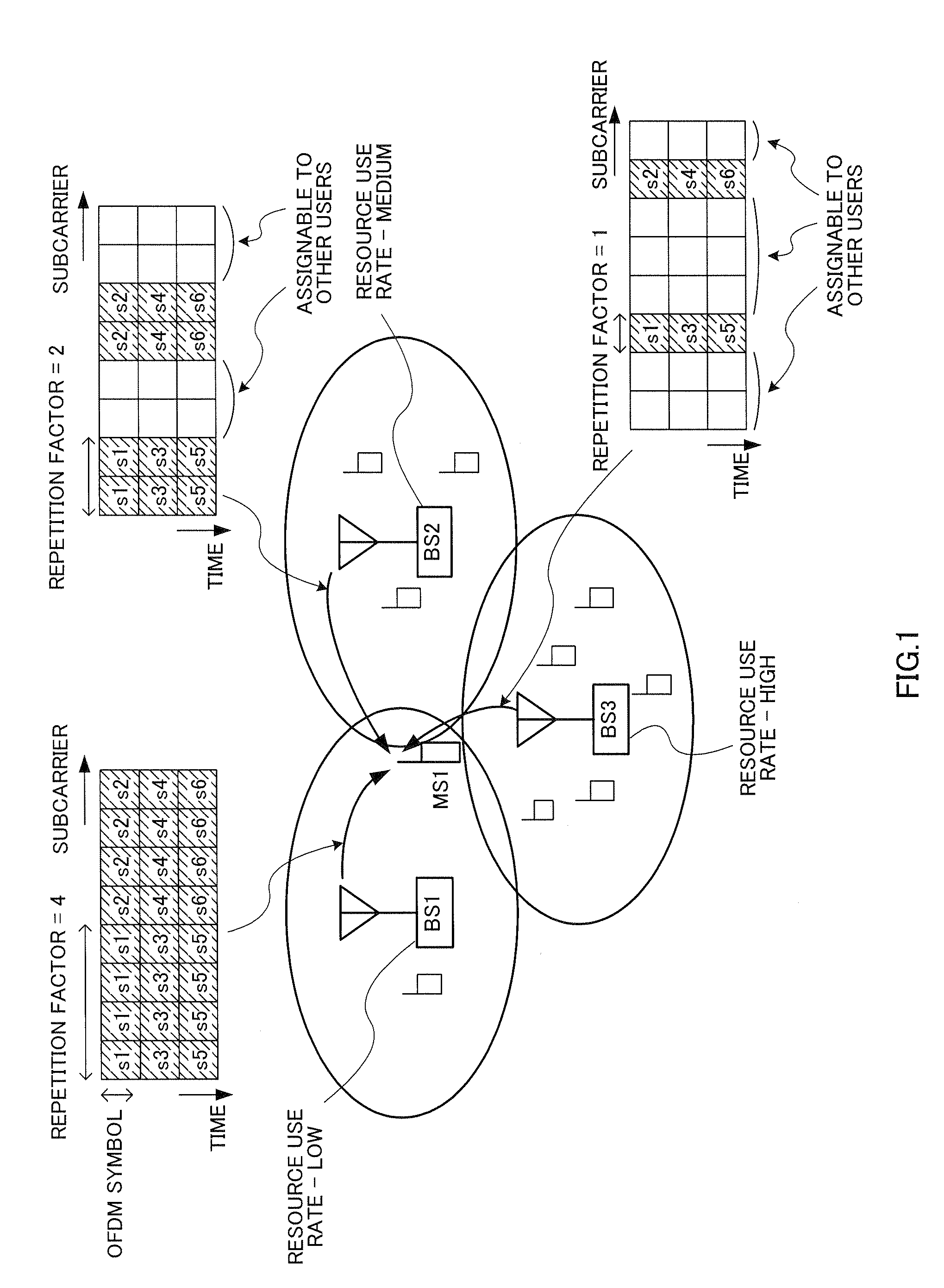Base Station Apparatus And Wireless Transmission Method
a technology of wireless transmission and base station, which is applied in the direction of electrical equipment, substation equipment, network traffic/resource management, etc., can solve the problems of increasing interference from other-cells, deteriorating transmission characteristics, and inability to ignore, so as to increase the number of users and efficiently allocate the resources of a radio communication system.
- Summary
- Abstract
- Description
- Claims
- Application Information
AI Technical Summary
Benefits of technology
Problems solved by technology
Method used
Image
Examples
embodiment 1
[0025]FIG. 1 shows an overview of Embodiment 1 of the present invention. Here, a case will be described here as an example where base stations in three cells (BS1, BS2 and BS3) transmit data to a mobile station (MS1) which is located near a cell boundary and is in the middle of soft handover. Furthermore, each base station carries out transmission based on a repetition OFDM scheme, and each transmission symbol is transmitted by performing transmission repeatedly.
[0026]In the present embodiment, for a mobile station which is located near a cell boundary and is in the middle of soft handover, each base station determines a repetition factor for data to be transmitted according to the degree of congestion of each cell including a resource use rate of each base station. In this way, it is possible to improve reception quality of the mobile station in the middle of soft handover and increase the number of users accommodated in a communication system.
[0027]For example, in FIG. 1, the reso...
embodiment 2
[0060]In Embodiment 2 of the present invention, by keeping the transmission rate of a mobile station located near a cell boundary at a required transmission rate or using minimum necessary resources, the number of users accommodated is increased. More specifically, the repetition factor at a connected base station (the base station to which the mobile station belongs) is determined using both the required repetition factor determined from the required transmission rate and SHO user repetition factor at SHO base stations (BS2 and BS3).
[0061]FIG. 5 is a sequence diagram showing exchange of signals between base station apparatuses BS1 to BS3 and mobile station MS1 according to the present embodiment. In this sequence, the processing is carried out until SHO request processing (ST1041) shown in the sequence of Embodiment 1, the same steps are allotted the same step numbers and will not be described.
[0062]In ST1040 and ST1041, BS2 and BS3 receive SHO requests and respectively determine r...
embodiment 3
[0077]In Embodiment 3 of the present invention, under the circumstance of the best effort traffic, throughput of a mobile station located near a cell boundary is improved fully and the number of users accommodated is increased. To be more specific, a connected base station determines an MCS (combination of a coding rate and a modulation scheme) for a mobile station for soft handover based on a repetition factor for each base station (BS1, BS2 and BS3).
[0078]FIG. 7 is a sequence diagram showing exchange of signals between base station apparatuses BS1 to BS3 and mobile station MS1 according to the present embodiment. This sequence shows the same processing up to repetition factor determining processing (ST1050 to ST1052) shown in the sequence of Embodiment 1, the same steps are assigned the same reference numerals and will not be described.
[0079]After the repetition factor is determined in ST1050 to ST1052, BS2 and BS3 report the determined repetition factors to BS1 (ST3010 and ST3011...
PUM
 Login to View More
Login to View More Abstract
Description
Claims
Application Information
 Login to View More
Login to View More - R&D
- Intellectual Property
- Life Sciences
- Materials
- Tech Scout
- Unparalleled Data Quality
- Higher Quality Content
- 60% Fewer Hallucinations
Browse by: Latest US Patents, China's latest patents, Technical Efficacy Thesaurus, Application Domain, Technology Topic, Popular Technical Reports.
© 2025 PatSnap. All rights reserved.Legal|Privacy policy|Modern Slavery Act Transparency Statement|Sitemap|About US| Contact US: help@patsnap.com



